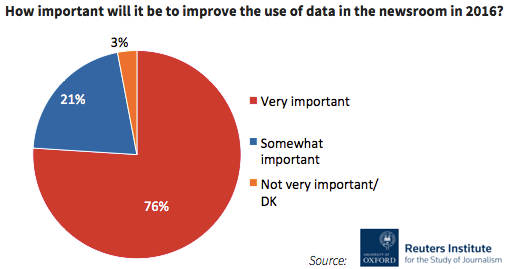2016: The Year of Data-Informed Decision-Making
Back in December, Parse.ly predicted that monetization would be one of the biggest challenges for digital publishers in 2016. However, a recent report from the Reuters Institute for the Study of Journalism suggests that digital publishers may have something else on their minds, as well.
Within the report, Research Associate Nic Newman explored what digital publishers expect to be some of the key developments in media, journalism, and technology in 2016. One of the top trends? Data-informed decision-making.
“Everywhere we will see the growth of analytics and data-informed decision-making in technology, marketing and even publishing. In a few years’ time, it will seem extraordinary how uninformed we once were.”
(Nik Newman, research associate, Reuters Institute for the Study of Journalism)
Just look at how far we’ve come.
Until just a few years ago, many digital publishers were under the assumption that data was actually detrimental to their newsrooms. Here were some common misconceptions (which Parse.ly cleared up in a blog post last year):
- Data and analytics are complex and best left to the analysts.
- Exposure to data lowers company morale.
- Data will force me to reduce my site’s values and goals to one number.
Today, we know that data can (and should) be accessible to everyone, that it can boost morale in unexpected ways, and that putting metrics into context can show multiple paths to success. As a result, data is increasingly becoming a top priority for digital newsrooms.
Now, it is becoming commonplace to have an analytics dashboard up and running in a newsroom; and, many publishers are taking steps to incorporate analytics into their content strategy. As they begin to better understand the complexities of this data, an internal cultural shift is taking place — encouraging writers, editors, freelancers, and others to understand and work with data.
The Reuters Institute surveyed 130 senior members of traditional or digital-born publishing companies who are responsible for digital strategy, and 76 percent of these people said it was “extremely important” to improve the use of data in newsrooms.

So what’s next?
Parse.ly spoke with Mr. Newman, who suggested:
“It’s really about changing the metrics they use from broken clicks and UBs to more meaningful and actionable metrics in the newsroom. That’s partly about tools, but it is also about breaking different types of content down and providing good benchmarks for what good looks like, segmenting by different formats, platforms and audiences. It’s about rooting all that in the values and objectives of the organisation and employing knowledgeable audience development people working with journalists in new ways.”
It’s possible that one of those ways will be to engage with third-party content distribution platforms such as Facebook and Google. Said Newman, “They know that only the most loyal people will go directly to their website or app so unless they are comfortable monetising a particular niche they need to reach out to new people in social media and other aggregator platforms.”
“The key thing,” says Newman, “will be to get the right terms and the right monetisation opportunities — so it will be a year of experiments, cat and mouse where all sides try to understand where the value is and crucially what audiences want.”
To delve into the full report from the Reuters Institute for the Study of Journalism, click here.